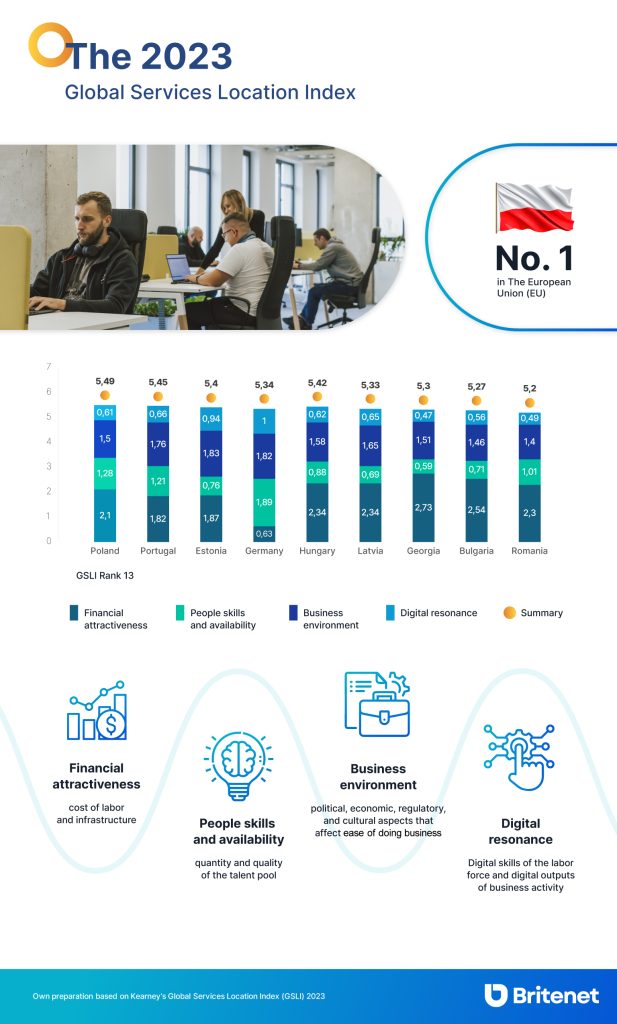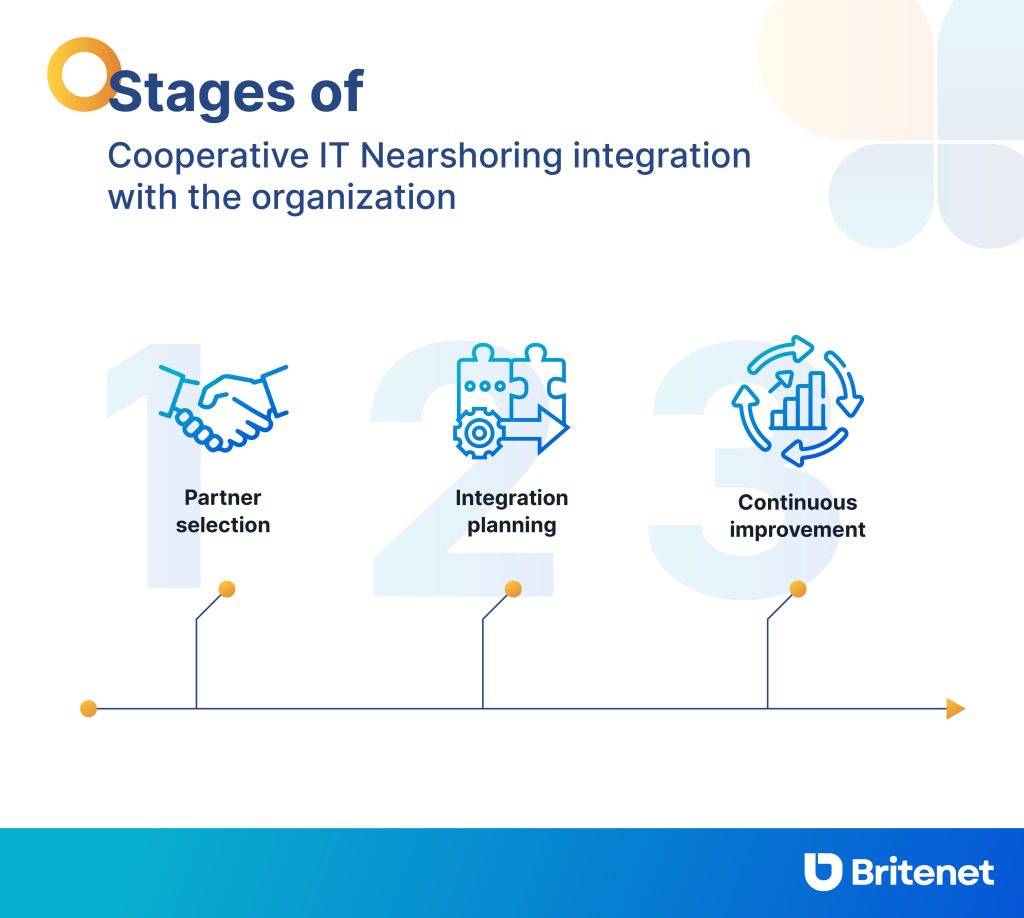The emergence of cooperative nearshoring marks a significant advancement in outsourcing within the technology industry. Designed as a collaborative approach to outsourcing, cooperative nearshoring involves partnering with providers located in geographically nearby countries. This model differs from traditional offshoring as it emphasises geographical proximity, time zone alignment, and cultural similarities. These factors, which eliminate communication barriers, also enhance the efficiency and cost-effectiveness of companies.
Key takeaways from this article
3 essential takeaways for a Chief Information Officer (CIO) considering cooperative IT nearshoring:
- The triangle of trust – A foundation for success.
The success of cooperative nearshoring is underpinned by the triangle of trust management model, consisting of the Site Manager, HR Partner, and Customer Satisfaction Manager. This model ensures operational excellence, talent nurturing, and client satisfaction.
- Strategic competitive advantage
Cooperative nearshoring boosts competitive advantage and innovation for firms exceeding €250M by leveraging time zone and cultural proximity. This enhances productivity, team integration, and operational agility.
- Accelerated Return on Investment (ROI)
Cooperative nearshoring is a strategic investment that accelerates ROI by navigating past common offshoring challenges like communication gaps and time zone differences. It’s a proven model that large companies have used to align quality with cost-effectiveness, enhancing productivity and fostering agility.

Part 1 – Why cooperative nearshoring is an asset for companies over €250M
For substantial corporations, surpassing the €250M mark, the advent of cooperative nearshoring marks a strategic pivot in the outsourcing landscape. This business model isn't just a service—it's a synergistic partnership that brings tangible benefits to the technological pursuits of your company.
Enhancing collaboration through proximity and cultural alignment
Cooperative nearshoring transcends geographical boundaries, harnessing the power of shared time zones and cultural similarities to foster real-time collaboration and intercultural synergy. This seamless integration not only facilitates immediate problem-solving and operational efficiency but also builds a foundation of trust and mutual respect, essential for innovative and successful IT projects.
Code Harmony: EF – Transforming IT with Years of Outsourcing Support
Accelerated project execution with shared business ethics
The cooperative nearshoring model emphasises the alignment of business ethics, which is crucial for IT executives managing complex projects. With a shared understanding of professional integrity, regulatory compliance and quality standards, companies can ensure that their nearshore partners are not just vendors but allies. This shared perspective on business operations leads to a more coherent approach to project management and execution, thus reducing the time-to-market for new technological initiatives.
Integrative team dynamics: blending onshore and offshore expertise
The cooperative element in cooperative nearshoring is not just about working alongside each other; it's about integrating the distinct strengths of diverse team members into a singular, robust force. When part of the service provider's workforce is onshore, residing within the native country of the client, it allows for a blend of perspectives that can lead to breakthrough innovations. This integrative dynamic ensures that the collective expertise of globally dispersed teams is harnessed to its full potential, driving forward the organisation's IT ambitions.
Optimised profitability through cost-efficiency
While cost-saving is a known benefit of traditional outsourcing models, cooperative nearshoring allows companies to optimise their savings without compromising on quality. By outsourcing to geographically closer regions with similar standards of living, companies can maintain high-quality output while benefiting from the economic differentials. This strategic cost-efficiency does not just improve the bottom line but also reallocates financial resources towards innovation and growth.
Cultivate an ecosystem of continuous improvement and learning
Another cornerstone of cooperative nearshoring is the continuous loop of feedback and improvement. The close-knit nature of these partnerships fosters an environment where feedback is not only encouraged but is also acted upon quickly. This culture of continuous learning and adaptation is critical for IT departments that must evolve with the ever-changing technological landscape. It is an environment where learning from each other is the norm and striving for excellence is the collective goal.
Enhanced communication for better decision making
Effective communication is pivotal for decision-making in IT. Cooperative nearshoring ensures that decision-makers have access to real-time communication with their outsourced teams. This aspect is particularly beneficial for CIOs and senior IT executives, who rely on timely data and insights to make informed decisions. The proximity of nearshore teams means that communication is frequent, clear, and nuanced, leading to better-informed strategies and a more responsive IT governance structure.
In essence, cooperative nearshoring does not just support IT collaboration; it amplifies it, turning geographically distributed expertise into a cohesive, innovative powerhouse that propels large organisations towards their strategic goals.
Part 2 – Savings and efficiency: the financial benefits of cooperative nearshoring
In the budget area of IT operations, the strategy of cooperative nearshoring stands out as a beacon of efficiency and economy. For large-scale organisations, where every euro counts and streamlining processes is not just a goal but a necessity, the financial implications of cooperative nearshoring are particularly significant.
Redefining cost-efficiency in IT operations
The traditional view of nearshoring as a mere cost-cutting tactic is a significant underestimation. The cooperative model transcends this by offering a dual advantage: it is both a lever for reducing expenses and a catalyst for enhancing quality. By partnering with service providers in geographically close regions, companies can benefit from lower operational costs due to economic differentials, without the sacrifice that often comes with lower-cost solutions. Service providers in these nearshore regions are often equipped with high-calibre IT professionals who uphold the same quality standards, ensuring that cost savings do not equate to a drop in quality.
Synchronicity breeds productivity
One of the most palpable financial benefits of cooperative nearshoring is the optimization of productivity. When teams operate in the same or similar time zones, it naturally leads to a more streamlined workflow. This alignment allows for real-time monitoring and quick responses to any arising issues, thereby accelerating the problem resolution process. For a Chief Information Officer, whose role often involves overseeing large, multifaceted IT projects, the ability to coordinate with nearshore teams without time delay is invaluable. It means projects can progress without the costly downtime that asynchronous communication can cause.
Agile response, agile spending
Cooperative nearshoring also offers financial benefits through its inherent agility. The proximity allows for swift adjustments and changes, which, in a field as dynamic as IT, can result in significant cost savings. The ability to adapt quickly to new technologies or project demands without the need for long-haul flights or extensive downtime can have a substantial impact on a company's bottom line.
Investment redirection: a catalyst for innovation
The savings gleaned from cooperative nearshoring do more than just improve the current fiscal year's balance sheet; they can be redirected into areas of innovation and growth. Funds that might have been allocated to cover the higher costs of traditional offshoring models can be reinvested into research and development, employee training, or even the exploration of new markets. For IT executives, this opportunity to reinvest savings into innovation can be the difference between trailing the competition and leading the market.
In summary, cooperative nearshoring offers large companies a powerful financial proposition: the ability to turn the cost-saving corner without cutting corners on quality, thus propelling their operations forward with both fiscal responsibility and operational excellence.
Part 3 – Return on investment with cooperative nearshoring
In the strategic calculus of IT leadership, the metric of Return on Investment (ROI) reigns supreme. When dissecting the financial viability of outsourcing models, cooperative nearshoring emerges as a compelling protagonist, offering a narrative of accelerated returns and minimised risks. For companies on the frontline of global competition, this approach not only makes budget-wise sense but also aligns with broader strategic imperatives.
Accelerated ROI through streamlined operations
The essence of cooperative nearshoring lies in its ability to dismantle the traditional barriers associated with outsourcing. Communication hurdles, often exacerbated by cultural and linguistic disparities in offshoring, are significantly reduced when partners share geographical and cultural proximities. Similarly, the alignment of time zones eradicates the delays inherent in waiting for responses or updates, thereby streamlining project timelines. These efficiencies contribute to a swifter realisation of benefits, compressing the ROI period, and allowing companies to reap the financial rewards of their investments sooner.
The impact of cooperative nearshoring on long-term Return on Investment in IT projects is profound. By revolutionising cost-efficiency, harmonising productivity levels, and reallocating savings towards innovation, we're setting the groundwork for a sustainable cycle of growth and technological advancement. This strategic approach to nearshore collaborations is pivotal, not just for enhancing the yield on our current investments but also for maintaining our agility, competitiveness, and resilience against forthcoming challenges. It's a foundation that positions us as pioneers in our industry, securing our leadership for the foreseeable future.
Michal Zieńkowski – Head of Technology at Britenet
Mitigating risks, maximising returns
Beyond the immediate efficiencies, cooperative nearshoring presents a risk-mitigated pathway to achieving strategic objectives. The close collaboration and integration with nearshore partners facilitate a deeper understanding and alignment of project goals, reducing the likelihood of costly misunderstandings or misalignments. Mitigating risks is essential for protecting the investment and guarantees a more predictable and positive return on investment.
What are the key safety standards to prioritize when cooperative nearshoring, and how can companies ensure compliance and effectively mitigate risk?
Case studies: empirical evidence of success
The theoretical advantages of cooperative nearshoring are compelling, but the real proof lies in its practical application. Several large companies have used the model as a cornerstone of their technology strategy, with considerable success. These studies serve as empirical evidence, highlighting not only the financial benefits, but also the strategic value of cooperative nearshoring. By analyzing these success stories, IT executives can gain insight into best practices and potential pitfalls, further justifying their investment decisions.
Strategic ROI: beyond the balance sheet
While the financial return on investment of nearshoring is tangible, it is important to recognize the broader strategic return on investment it offers. By fostering stronger partnerships, increasing flexibility and aligning more closely with strategic goals, this approach contributes to a company's competitive advantage. It is an investment that pays dividends not only financially, but also in terms of innovation, market position and long-term growth potential.
In short, the ROI of nearshoring goes beyond mere cost savings to include strategic benefits that resonate with the ambitions of large companies. It is a model that not only promises a faster return on investment, but also aligns with a broader vision of maintaining technological and competitive leadership in an ever-changing global landscape.
Part 4 - The triangle of trust: the future of IT nearshoring
The journey toward integrating cooperative nearshoring into the operational fabric of an organization is both strategic and meticulous. It involves a series of well-thought-out steps, from selecting the right nearshoring partner to conducting a thorough cost-benefit analysis and ensuring the smooth integration of the project. However, underpinning this transformation is the solid framework provided by dedicated centers, particularly through the innovative management model developed by Britenet - the Triangle of Trust. This model is based on three key roles: Site Manager, Human Resources Partner and Customer Satisfaction Manager, each of whom contributes uniquely to the success of the project.
The Site Manager: orchestrating operational excellence
The Site Manager stands at the helm of the nearshore operation, ensuring that the day-to-day functions align with both the strategic objectives of the client and the operational capabilities of the nearshore team. This role involves overseeing project timelines, resource allocation, and technological infrastructure. The Site Manager acts as a bridge between the client's expectations and the nearshore team's delivery, ensuring projects are executed efficiently and effectively.
The Human Resources Partner: nurturing talent and culture
Human Resources Partner plays a key role in the trust triangle, focusing on the human aspect of the nearshoring center. This includes not only recruiting the best talent that fits the client's specific needs, but also fostering a work environment that reflects the client's culture and values. The HR Partner ensures that the team remains motivated, engaged and constantly evolving, which is critical to maintaining high performance and innovation in dedicated teams.
The Customer Satisfaction Manager: ensuring client delight
At the heart of cooperative nearshoring's success is the unwavering focus on client satisfaction, a responsibility that falls to the Customer Satisfaction Manager. This role involves regular communication with the client to gauge satisfaction levels, identify areas for improvement, and implement feedback into actionable insights. By keeping a finger on the pulse of the client's experience, the Customer Satisfaction Manager ensures that the nearshore partnership not only meets but exceeds client expectations.

Guaranteeing success through the triangle of trust
The synergy between the Site Manager, HR Partner, and Customer Satisfaction Manager creates a dynamic framework that ensures projects are self-managed, cross-functional, and dedicated to the client's success. This triangle of trust is fundamental to the dedicated centres' approach, providing a comprehensive management model that covers operational efficiency, talent management, and client satisfaction.
Adopting cooperative nearshoring: a strategic roadmap
For organisations looking to adopt cooperative nearshoring, understanding and implementing the triangle of trust is crucial. This involves:
- Partner selection: choosing a nearshore partner that can offer a dedicated centre managed by the triangle of trust.
- Integration planning: working closely with the nearshore partner to integrate their teams and management models into your operations seamlessly.
- Continuous improvement: leveraging the feedback loop provided by the Customer Satisfaction Manager to refine and enhance collaboration.

Embracing cooperative nearshoring, positions you for the future, with a strong foundation in trust, teamwork, and unwavering focus on client fulfilment. By adopting this approach, organisations can not only ensure the smooth integration of nearshoring into their operations but also set the stage for sustained success and innovation in their projects.
Conclusion
Cooperative nearshoring represents a paradigm shift in the way large companies, particularly those with revenues over €250M, approach IT outsourcing. This model transcends traditional offshoring by fostering a partnership that is not only geographical and cultural but also deeply collaborative.
This article highlights the multifaceted benefits of cooperative nearshoring, from strategic advantages and enhanced collaboration to financial optimization and an accelerated return on investment.
The introduction of Britenet's trust triangle, management model, comprising the Site Manager, HR Partner, and Customer Satisfaction Manager, further strengthens the case for cooperative nearshoring. This model ensures that projects are not just managed but are led with a vision that aligns closely with the client's goals, fostering an environment of trust, efficiency, and mutual success.
For CIOs and senior IT executives contemplating the adoption of cooperative nearshoring, this article offers a comprehensive overview of its strategic value. Cooperative nearshoring is not merely a cost-saving measure but a strategic initiative that can enhance operational efficiency, foster innovation, and ultimately contribute to the competitive edge of large organisations in the global market.
As we look toward the future, the adoption of cooperative nearshoring by companies is not just a trend but a strategic move toward building more resilient, innovative, and competitive IT operations. It’s an approach that promises immediate benefits and long-term strategic gains, positioning companies for success in an increasingly digital and interconnected world.



